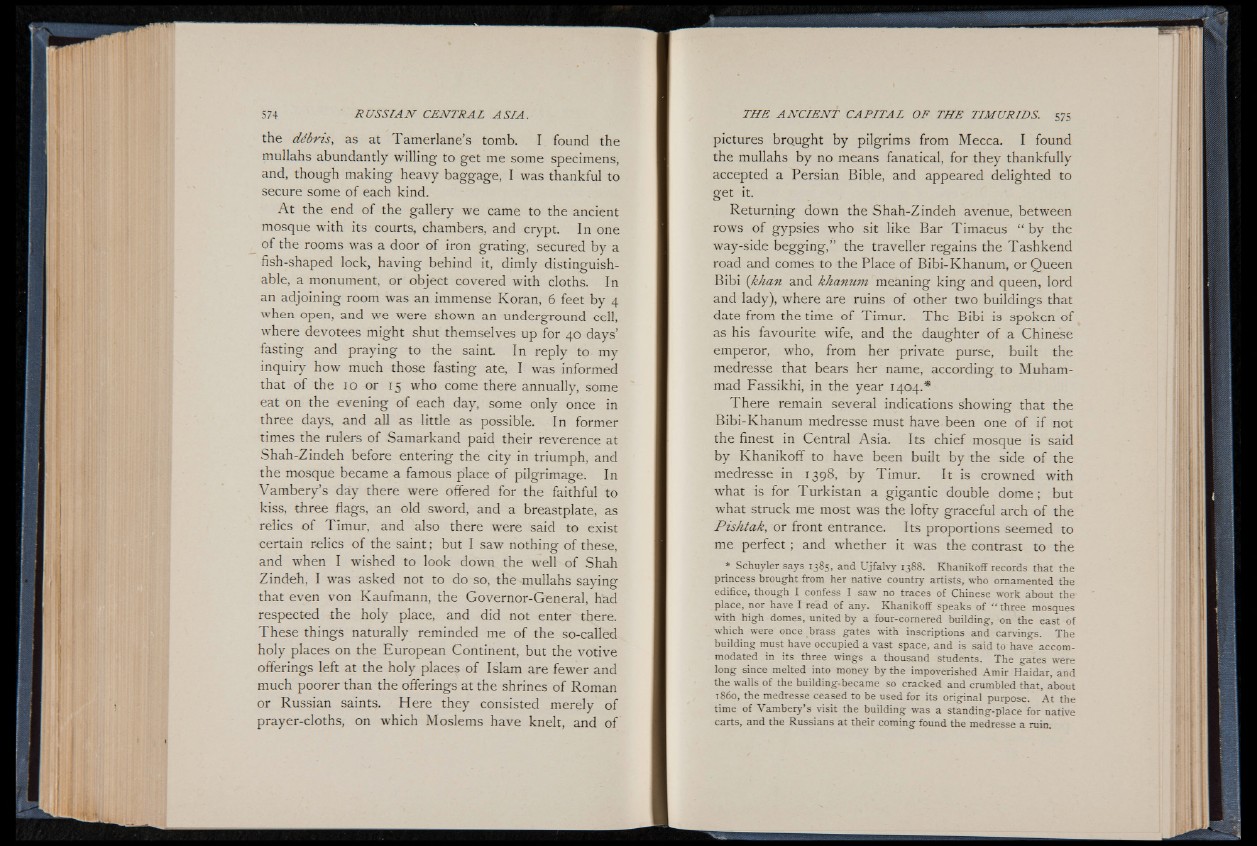
the débris, as at Tamerlane’s tomb. I found the
mullahs abundantly willing to get me some specimens,
and, though making heavy baggage, I was thankful to
secure some of each kind.
A t the end of the gallery we came to the ancient
mosque with its courts, chambers, and crypt. In one
of the rooms was a door of iron grating, secured by a
fish-shaped lock, having behind it, dimly distinguishable,
a monument, or object covered with cloths. In
an adjoining room was an immense Koran, 6 feet by 4
when open, and we were shown an underground cell,
where devotees might shut themselves up for 40 days’
fasting and praying to the saint In reply to my
inquiry how much those fasting ate, I was informed
that of the 10 or 15 who come there annually, some
eat on the evening of each day, some only once in
three days, and all as little as possible. In former
times the rulers of Samarkand paid their reverence at
Shah-Zindeh before entering the city in triumph, and
the mosque became a famous place of pilgrimage. In
Vambery’s day there were offered for the faithful to
kiss, three flags, an old sword, and a breastplate, as
relics o f Timur, and also there were said to exist
certain relics of the saint ; but I saw nothing of these,
and when I wished to look down the well of Shah
Zindeh, I was asked not to do so, the mullahs saying
that even von Kaufmann, the Governor-General, had
respected the holy place, and did not enter there.
These things naturally reminded me of the so-called
holy places on the European Continent, but the votive
offerings left at the holy places of Islam are fewer and
much poorer than the offerings at the shrines of Roman
or Russian saints. Here they consisted merely of
prayer-cloths, on which Moslems have knelt, and of
pictures brQught by pilgrims from Mecca. I found
the mullahs by no means fanatical, for they thankfully
accepted a Persian Bible, and appeared delighted to
get it.
Returning down the Shah-Zindeh avenue, between
rows of gypsies who sit like Bar Timaeus “ by the
way-side begging,” the traveller regains the Tashkend
road and comes to the Place of Bibi-Khanum, or Queen
Bibi (khan and khanum meaning king and queen, lord
and lady), where are ruins of other two buildings that
date from the time of Timur. The Bibi is spoken of
as his favourite wife, and the daughter of a Chinese
emperor, who, from her private purse, built the
medresse that bears her name, according to Muhammad
Fassikhi, in the year 1404.*
There remain several indications showing that the
Bibi-Khanum medresse must have been one of if not
the finest in Central Asia. Its chief mosque is said
by Khanikoff to have been built by the side of the
medresse in 1398, by Timur. It is crowned with
what is for Turkistan a gigantic double dome; but
what struck me most was the lofty graceful arch of the
Pishtak, or front entrance. Its proportions seemed to
me perfect; and whether it was the contrast to the
* Schuyler says 1385, and Ujfalvy 1388. Khanikoff records that the
princess brought from her native country artists, who ornamented the
edifice, though I confess I saw no traces of Chinese work about the
place, nor have I read of any. Khanikoff speaks of “ three mosques
with high domes, united by a four-cornered building, on the east of
which were once brass gates with inscriptions and carvings. The
building must have occupied a vast space, and is said to have accommodated
in its three wings a thousand students. The gates were
long since melted into money by the impoverished Amir Haidar, and
the walls of the building.became so cracked and crumbled that, about
t 8 6 o , the medresse ceased to be used for its original purpose. A t the
time of Vambery’ s visit the building was a standing-place for native
carts, and the Russians at their coming found the medresse a ruin.